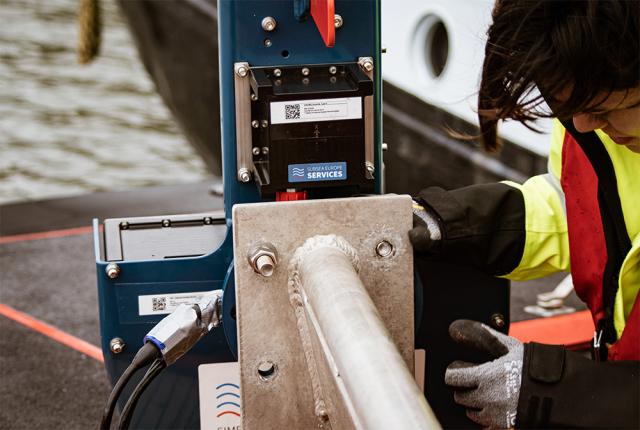
The iHSS arrives preconfigured to simplify and expedite installation on any vessel of opportunity.
(Source: Subsea Europe Services Gmbh)
Presented by:
Editor's note: This article originally appeared in the May issue of E&P Plus.
Subscribe to the new E&P digital newsletter here.
Due in part to the early industry acceptance of new technologies and methodologies for planning and deployment over the past decade, the cost per KwH of energy produced by offshore wind farms continues to fall. With offshore wind energy now more than economically viable, the industry must work even harder to optimize operations and maintenance (O&M) to ensure costs to the end-consumer stay low, while meeting the inevitable extra demand on capacity coming from price competitiveness.
Cost reduction programs are more essential for energy companies and offshore wind farm operators than ever, and it’s clear that the squeeze will tighten as the industry looks toward a future of much larger and more powerful wind turbines, located farther from shore. This development is a direct result of the need to deliver on strict carbon reduction plans as guided by the Paris Agreement and the U.N. Sustainable Development Goals. As an example of the pressures faced by the offshore wind industry, the U.K. government’s commitment of reaching 30 GW installed capacity by 2030 was subsequently amended to 40 GW, with a target of net zero carbon emissions by 2050.
Sector growth and stability will depend upon innovation in the design of wind turbines, new installation processes and digitalization for operational safety and efficiency. And while large technology and offshore service companies will be in the spotlight, cost reductions will also come from countless smaller players, working across the entire offshore wind farm value chain. Projects as simple to grasp as torque monitoring on bolts or as complex as AI-powered robotics to crawl turbine blades looking for cracks may solve hundreds of potential pinch points where time and money can be saved.
Unforeseen circumstances
Optimizing the acquisition of marine data that enable subsea engineering and maintenance can also influence the O&M bottom line. The requirement for an accurate view of the seabed and the water column is present from the planning stages throughout the entire life cycle of a wind farm, and as such, marine survey is a visible cost center. Planned surveys are an established and accepted cost with a predictable impact on budgets, but marine data are increasingly needed on a more urgent or ad hoc basis due to unforeseen circumstances that are impossible to budget for in advance.
Such circumstances might include the loss of an expensive tool or piece of important equipment over the side of a vessel during turbine installation or subsea inspection, maintenance and repairs. Additionally, especially in the North Sea, unexploded ordinance (UXO) leftover from World War II can regularly cause work to stop on offshore wind farms. In both scenarios, the cost of nonproductive time (NPT) from extended vessel charter, equipment hire and crewing costs as well as late and non-completion penalties demands a fast resolution to the problem at hand.
With wind farms often located 30 km to 50 km from shore, the project owner generally looks to small but fast vessels of opportunity that can get on site quickly for what is usually only a short survey. But while such vessels are usually readily available for hire in most commercial ports, acquiring and installing the right hydrographic equipment for the survey and finding the expertise to operate it can take days or weeks, all the while the cost of NPT continues to rise.
Often referred to as gap-filler surveys, these projects are usually defined by the need for industry standard multibeam echosounder (MBES) solutions with little notice prior to the day of the survey. This demands a certain flexibility in the logistics chain, which too often isn’t available. Even clearly urgent projects can be forced to wait while the equipment needed is located and delivered from another country or even continent.
Simplified deployment
Simplifying the deployment and use of expensive, complex MBES systems has proven a successful starting point to enabling more cost-effective gap-filler surveys. Significantly, the design of a new integrated Hydrographic Survey System (iHSS) has made adding precise survey capabilities to any vessel of opportunity much easier. Able to acquire data to the new IHO S-44 Exclusive Order standards, the iHSS is a ready to mobilize solution based on MBES’ made by R2 Sonic, workstation, software, inertial navigation system and flexible mounting.
With stocking efforts to ensure availability, an iHSS can be virtually anywhere in Europe next day and mobilizing the system generally takes less than an hour on most vessels as it comes preconfigured with all components already integrated. It features an all-in-one pole mount design with multibeam transceiver, Inertial Motion Unit and GNSS antennas in one reference frame, which simplifies installation even further and reduces potential errors from inconsistent or wrong offsets, contributing to the iHSS’ ability to deliver data of the highest quality.
The combination of technical solution, standardized workflows and streamlined logistics means that short jobs, long transit times and high-quality data are no longer a contradiction in terms for the marine survey world. This was shown in an earlier contract when marine survey company Nicola Engineering GmbH was tasked by an offshore wind service company to carry out a rapid survey to locate and identify a small feature on the seabed in the North Sea. Rather than wait for a large, slow commercial survey vessel to become available in the area, Nicola Engineering turned to Dutch shipyard and charter company ProMarine BV to mobilize a small, fast survey boat with relevant offshore permits already in place.
The combination of the iHSS, a fast, class-approved survey boat and skilled operators met the requirement for a high-resolution MBES to survey the target—a small subsea feature approximately 1 m in length in water depths exceeding 30 m. The project was completed within two days of Nicola Engineering receiving its brief, and the survey was finished in a single day out of a small port in the Netherlands. Mobilization and calibration of the whole system took about two hours. The iHSS successfully located and identified the feature quickly and at a considerably lower cost than using a commercial survey ship.
Autonomy platform
The vision behind the iHSS is that service companies and subcontractors can quickly add industry standard survey capabilities to any vessel of their choosing (or any vessel that’s available in urgent situations). The technology integration reduces complexity to a point that the system is almost plug and play, which contributes to expediency in getting vessels and equipment to a survey site quickly and cost effectively.
The technology integrations have also made operating the iHSS easier when compared to standard MBES systems. Marine survey expertise and training are still needed to use the iHSS, but the integrated nature positions it as a platform for introducing more automation and ultimately enabling autonomous operations. Onboard expertise is integral to conducting marine surveys and post processing, but with the iHSS, AI-powered autonomy may one day deliver results to the same standard that professional surveyors can achieve today.
Fleets of unmanned vessels conducting autonomous survey operations on wind farms with monitoring and management by marine surveyors on shore have the potential to deliver significant O&M cost savings. The vision is long-term. For today, the iHSS concept and Nicola Offshore, the marine survey company it helped to create, are simplifying, specializing and lowering the cost of on-demand marine surveys. These developments may be low-ley in the overall theme of offshore wind farm opex, but nonetheless they do play a part keeping the cost per KwH of wind energy on its downward trend.
Recommended Reading
Baker Hughes Awarded Saudi Pipeline Technology Contract
2024-04-23 - Baker Hughes will supply centrifugal compressors for Saudi Arabia’s new pipeline system, which aims to increase gas distribution across the kingdom and reduce carbon emissions
PrairieSky Adds $6.4MM in Mannville Royalty Interests, Reduces Debt
2024-04-23 - PrairieSky Royalty said the acquisition was funded with excess earnings from the CA$83 million (US$60.75 million) generated from operations.
Equitrans Midstream Announces Quarterly Dividends
2024-04-23 - Equitrans' dividends will be paid on May 15 to all applicable ETRN shareholders of record at the close of business on May 7.
SLB’s ChampionX Acquisition Key to Production Recovery Market
2024-04-21 - During a quarterly earnings call, SLB CEO Olivier Le Peuch highlighted the production recovery market as a key part of the company’s growth strategy.
PHX Minerals’ Borrowing Base Reaffirmed
2024-04-19 - PHX Minerals said the company’s credit facility was extended through Sept. 1, 2028.






